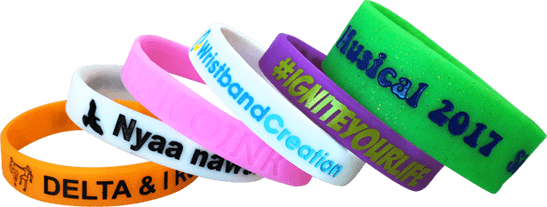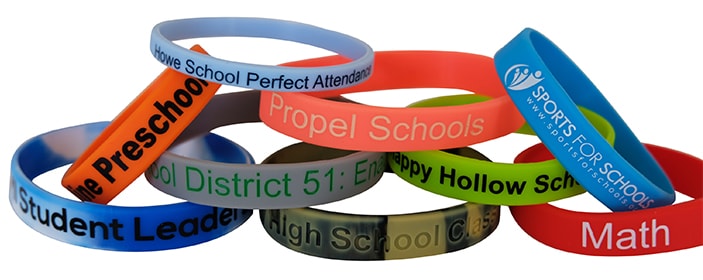Silicone wristbands became mainstream, so to speak, during 2004 with the rise of the bright yellow Livestrong “baller band.” Since then, there was no looking back for this humble bracelet. In fact, while the hype surrounding silicone wristbands has died down considerably, they still remain to be highly popular marketing and promotional materials, among many other uses.
Despite their popularity, however, not many people know about how silicone wristbands are made. Here’s a look at the most fundamental steps of manufacturing these accessories.

Material Processing
The first step in making silicone wristbands is processing the raw material, which is primarily the silicone. It’s the ideal material to use in these wristbands due to its flexibility. Silicone is also water resistant and can withstand a fair amount of heat and cold, unlike other materials that may shrink or become brittle over time.
The polymer usually come in blocks or cylinders, which are then fed into a machine that compresses the silicone to achieve the correct consistency. The time it takes to accomplish this step simply depends on the amount of silicone to be rolled and processed.
Once the desired consistency is achieved, pigments can then be added to provide the base color of the wristbands. The pigments and the silicone sheets are rolled together using the same machine. Wristband Creation uses the Pantone Matching System so the exact color is replicated onto the silicone. The pigments and the silicone may need to be passed through the rollers multiple times to achieve an even distribution of color.
It can be argued that silicone wristbands and bracelets reached the height of their popularity, fashion-wise, during the 1980s, when even Madonna was seen wearing them (albeit in all-black). Their resurgence could be attributed to nostalgia, when 80s fashion became popular once more especially amongst pop stars and celebrities.
However, in 2004, customized silicone wristbands became a worldwide phenomenon when famed cyclist Lance Armstrong teamed up with Nike to promote the Livestrong Foundation, which supports cancer patients, through the help of bright yellow bands debossed with the word “Livestrong.” Since then, there was no stopping the rise of the wristband as a marketing and fund-raising tool. Even fellow athletes like tennis star Andy Roddick used it (along with their considerable fame) to promote their personal advocacies.
Today, the so-called “hype” surrounding silicone wristbands is not as big. However, these accessories still have a huge part in marketing campaigns all over the world. In fact, customized wristbands gave, and continue to give, smaller names and organizations a chance to be recognized and level the playing field a little.
Why are Wristbands Still Popular Marketing Tools?

There are many reasons why wristbands continue to enjoy such a high level of popularity, even when they are compared with other marketing tools such as pens, USB flash drives, coffee mugs, or key chains. For one, silicone wristbands can serve various purposes. During an event, for example, they can be used for both identification and giveaways. Outside it, they can provide more mileage for a brand or organization when people wear them as fashion accessories.
Silicone wristbands are also very affordable, which is a big plus for both the company and the customer or supporter. Wristband Creation’s debossed wristbands, in particular, cost only $0.36 per piece for an order of 100 half-inch-sized wristbands. This makes them easier to both produce and sell at a profit, should an organization need to raise funds. In fact, with the resulting audience reach that a single wristband can generate, you can say that an investment of pennies can be worth millions to your brand.
Another advantage of silicone wristbands, which adds to their popularity, is that they can easily be used to target different audiences. Whether you are convincing multi-millionaires to support your cause or encouraging young children to learn more about your advocacy, you can appeal to almost any market segment with a silicone wristband.
Wristbands also have various customization options, design-wise. The trend may have started with wristbands with debossed text, but these days, there are more styles to choose from. Wristband Creation has eight to choose from, including the aforementioned debossed, as well as embossed (raised instead of engraved text), deboss-fill (the engraved portion is of a different color), imprinted, emboss-printed, dual layer, figured, and even blank wristbands. We also use the standardized Pantone Matching System to make sure that the exact color in the designed is reproduced exactly as it is.
Finally, what makes these printable wristbands such popular marketing tools is that, due to all the reasons stated above, everybody wins with them. For the company, charity, or cause, the wristbands can help generate income, interest, and publicity even with a minimal cash capital. For those who bought and are wearing the wristbands, it helps showcase their support and pride of being able to contribute to something worthwhile, even in a small way.
The bottomline is this: trends may come and go but silicone wristbands are definitely here to stay. They are inexpensive yet powerful (not to mention eco-friendly) tools that give a physical, measurable aspect to word-of-mouth marketing that work as effectively for start-ups and micro-enterprises, as they do for large corporations.
Once the colors are mixed evenly into the silicone, they are rolled into sheets for cutting. Other customization options like glitters or DEET-free mosquito repellent may also added after the colors are mixed.
Preparation and Molding
After processing, the colored silicone is covered in a thin sheet of plastic and then passed through a machine to be cut into strips. The strips are then weighed and cut into smaller strips, which will then be placed into the mold. The size of the strips depend on the desired thickness of the wristband; for reference, Wristband Creation’s silicone wristbands are either 2mm or 3mm thick.
Depending on the design of the wristband, manufacturers can place as many colored strips of silicone into the mold, which will have grooves or stamps embedded onto the edges to emboss or deboss text and icons. Wristband Creation also offers blank wristbands; the mold for this kind of wristband has smooth, plain edges.
Painting
You can also choose not to have your wristbands embossed or debossed, but rather imprinted with a design using high-quality inks and paints. Once the silicone is molded to shape using the same machine used to mold blank wristbands, they will then be spray-painted with the corresponding design. Painting is also an additional step for deboss-filled wristbands and emboss-printed wristbands, in which the sunken or raised portions are manually filled or sprayed with paint, respectively.
Finishing
After the molding process, the excess material will have to be removed. These are the thin, translucent sheets that form at the bottom of the mold, as well as strips of excess silicone at the edges. This process is usually done by hand using very sharp cutters and scissors.
From here, all that is left to do is to pack the wristbands for shipping, whether in bulk or in individual bags. Wristband Creation offers various individual packaging options, including transparent poly-bags, white opaque poly-bags printed with your preferred design, flat board packaging, and card insert packaging.
Customized silicone wristbands are very affordable to produce, indeed, but don’t let that cheap price tag fool you into thinking that it can’t do a good job. Whether you’re drumming up support for your chosen advocacies, raising awareness for a startup company, or promoting an established brand, the word-of-mouth marketing that a single wristband can generate can be worth thousands of dollars of publicity.

